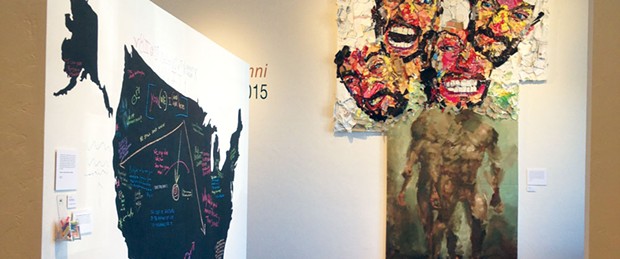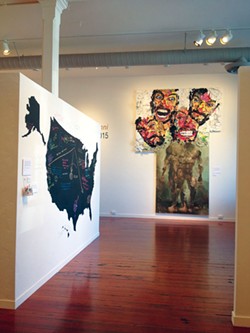[
{
"name": "Top Stories Video Pair",
"insertPoint": "7",
"component": "17087298",
"parentWrapperClass": "fdn-ads-inline-content-block",
"requiredCountToDisplay": "1"
}
]
Young Alumni 2015 features works by 40 recent graduates from the Humboldt State University Art Department. While subject matter and execution can be bewilderingly diverse in a big group show like this, unifying themes surface once you spend time with the work. The show is essentially a core sample of young creativity — and as such, it offers an intriguing glimpse of what's in young artists' minds.
At the gallery entrance, Renée Calway's thought-provoking yet accessible "Bored of Education" invites viewers to comment on the distorted U.S. market for higher education by annotating a large-scale map of the United States with chalk.
To the right, "Impasse," a monumental mixed media painting by Lance Borowitz revisits the 1980s in search of a modern-day Everyman. Start at the bottom and let your eyes drift up: you'll see two stubby, mud-colored bodies, each of which sprouts a pair of shiny, violently colored heads made out of fragments of broken ceramics and plastic packaging. The grotesque head cluster way overshoots the boundaries of the original canvas, pushing at the margins of gallery space, while their dowdy bodies dwindle into irrelevance. We're looking at a bloated set of heads crammed with nothing but slick pictures and the detritus of recent purchases, a networked headspace in thrall to consumerism.
There are shout-outs to Georg Baselitz and Julian Schnabel, two major figures of the bombastic neo-expressionism that dominated sectors of the New York art world during the 1980s. But there's a critical twist. At the close of the Me Decade, neo-expressionism resurrected the figure as a vehicle for ego; in contrast, Borowitz paints the figure in order to issue a savage, unironic report on the contemporary human condition.
Several of the strongest artists here use formally oriented processes that mirror or echo natural forces. Joseph Gustavson's brooding photographs show rocky coastlines wreathed in fog, battered by waves and almost lost to view. Alexandra Zotter shows small colonies of identical, organically shaped ceramic units executed in soft, matte colors that make them look oddly edible, like marzipan models of viruses. Lora Martin's suspended cylinder of white twine looks futuristic, yet homespun; think of it as a low-tech Star Trek teleporter, refashioned by the Amish for a post-apocalyptic desert cult. Brendan Bennett's interlocking ceramic units are similarly foreboding: They conjure a harsh, posthuman environment dominated by the primal forces of earth and fire.
Many artworks here offer visions of not fitting the confines of gender categories — or of growing up female in what can still be a deeply misogynistic culture. Artists have been making work that grapples with these subjects since the 1970s, but the themes continue to resonate — which suggests the degree to which true gender equality has yet to be achieved, and the degree to which hurtful objectification still plays a major role in girls' experiences.
Sharon Ruchte's fun, primitively styled painting "Guilty Pleasure" gives us a first-person POV of a whole CVS-load of cosmetics, lotions, hair and body products tumbled across a Barbie-pink bathroom countertop. It's like a painting Kim Kardashian might have made, if she had been raised by wolves.
Marval Rechsteiner's shiny, brightly colored, rough-hewn ceramic sculptures appear to be morphing in and out of various states of constraint. They are gnarly, knobbly forms, vaguely torso-shaped, like exoskeletons. They contain voids and yet we can't see what is cached there. The artist's statement relates these objects to the autobiographical experience of transitioning from female to male. The fact that many of the ceramic units appear to be cast from egg cartons is surely relevant.
To balance this exuberance, Nadia Bueno-Torres gives us a sad painting on mylar and acetate titled "This Culture Has Gone Completely Mad." Here, a nude woman hugs her knees in despondency, face hidden, watercolor pigments streaming like bodily fluids from her soft form.
Alexandra Felt's pastels of female nudes flip the bird at mainstream media representations by showing menstruating women in sexy poses. The pictures breach taboo to call out the glaring disconnect in the way mass media treats women's bodies. Media images of female bodies are sexualized — Photoshopped, glossed, abstracted and sanitized — and dehumanized even as women's real, fleshly bodies are depicted as gross problem zones requiring increasingly involved, expensive regimes of discipline and maintenance.
The other emerging theme here is the importance of photography. There's a wide variety of good photography in this show. There are 35 mm street photographs in the tradition of giants like Robert Frank, Gary Winogrand and Henri Cartier-Bresson, artfully structured visual narratives and allegories of self-exploration.
Julie Lovich shows a modestly sized photo diptych titled "Sublunary," composed of two grainy, horizontally ordered black-and-white images related in suggestive but unclear ways. Above, a young woman appears to be crawling towards a pile of rubble; below, detritus flickers in and out of focus. These are images that — to their credit — contain more information than can be described here.
Ryan Filgas is a gifted storyteller. His theatrical color images, set outdoors, offer just enough narrative clues to get the brain busily spinning potential interpretations. Each picture could generate micro-fiction: Why is this flannel-clad duo disappearing so hastily into the woods in the middle of the night? Why is that woman standing in the soggy landscape of the bottoms at dawn with a shovel?
Edith Sullivan photographs a "Dead Cat" that lies supine in tall grass, eyes open, tabby fur already beginning to mat. Some unseen hand has balanced a roadside sprig of radish bloom between the cat's paws, to mark the loss. That detail cut through my sangfroid. Who hasn't encountered a small death that made us feel the cold prickle of our own mortality? And who'd have the audacity to own that sensation and picture the tableau?
Stop by this exhibit before it closes on Sunday, Sept. 6. There will be a closing reception on Sept. 5 from 6 to 9 p.m. during Arts Alive.
more from the author
-
Nancy Tobin's CRy-Baby Installation at CR
- Feb 22, 2024
-
Truth Units
Bachrun LoMele's Burn Pile/The Andromeda Mirage at the Morris Graves
- Sep 7, 2023
-
Ruth Arietta's Illusory Interiors at Morris Graves Museum of Art
- Aug 10, 2023
- More »

































